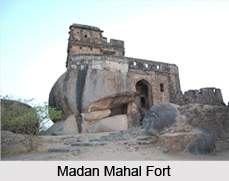 The Madan Mahal Fort, located in the city of Jabalpur in the Indian state of Madhya Pradesh, is a small but enchanting fortified garrison standing atop a rocky hill in the south western region of the modern city. Perched on the hilltop at a height of approximately 515 metres, it was erected by the Gond ruler Raja Madan Shah in the 11th century, at the time of the Gondwana dynasty rule in central India. Based on a single stone rock of granite, the fort in its earliest days served the purpose of being a watch tower and military barrack on vigil for invaders and attackers. The fort dominates the skyline and provides a panoramic view of the town and city around it.
The Madan Mahal Fort, located in the city of Jabalpur in the Indian state of Madhya Pradesh, is a small but enchanting fortified garrison standing atop a rocky hill in the south western region of the modern city. Perched on the hilltop at a height of approximately 515 metres, it was erected by the Gond ruler Raja Madan Shah in the 11th century, at the time of the Gondwana dynasty rule in central India. Based on a single stone rock of granite, the fort in its earliest days served the purpose of being a watch tower and military barrack on vigil for invaders and attackers. The fort dominates the skyline and provides a panoramic view of the town and city around it.
History of Madan Mahal Fort
Madan Mahal Fort served as a Gond military post to keep eye on nearby areas and track any military expedition towards their region. The main fort was in the plains, called the Garha fort, where the Kings and the royal family members used to stay. The fort is well associated with the Gond Queen, Rani Durgavati, and her son, Raja Madan Singh, who was the 10th Gond ruler. The fort was a pleasure palace for Madan Singh. Rani Durgavati died fighting the Moguls and is hailed as a martyr in Indian history. She had also built numerous temples and tanks scattered around Jabalpur, chiefly around her Garha principality.
Architectural Features of Madan Mahal Fort
The Gondwana rulers reigned over Jabalpur, Mandla and surrounding regions. Madan Mahal is a fort built by them, though not exactly an architectural marvel, the little fort is characterized by the intrigue of ancient monuments in India.
The Madan Mahal Fort is constructed on a single granite stone, elevated at a height of about 515 meters on the hill of the same name. The balancing rock is a huge stone balanced on the tip of another. It is a geological wonder on the way to the fort, with one coming across a number of shrines including medieval structures like Sangram Sagar and Bajnamath, built by the famous Gond King Sangram Shah, between 1480 and 1540 AD.
The Madan Mahal Fort is rather compact in design yet was fully equipped for military operations and encounters. The fort encompassed the main pleasure chamber of the rulers, war rooms, stables, secret passages, ancient scripts, corridors and a small reservoir, all of which can be seen inside the fort. The rooms of the fort were strategically designed, those in front of the main structure having had probably lodged the royal military troops.
All these architectural arrangements of the Madan Mahal Fort indicate that it was basically a military post where army men and their horses were kept. The maintenance and protection of this historical monument has been undertaken by the Archaeological Survey of India.
There are also many myths floating related to the Madan Mahal Fort. It is said to harbour gold bricks and Gond treasures hidden somewhere within it, in accessible underground folds. An underground tunnel covering a long distance is said to be located somewhere around the precinct - a possible escape route and transportation artery of the Gonds.
Best Time to visit Madan Mahal Fort
Madan Mahal Fort, being a heritage tourist destination, can be visited during any season, although the ideal time to visit the fort is from October to March, owing to pleasant climatic conditions, with accommodations available for tourists in the Jabalpur city.
Visiting Information to Madan Mahal Fort
The Madan Mahal Fort in the city of Jabalpur is conveniently accessible.
By Air: The nearest airport to Madan Mahal Fort is the Jabalpur Airport, 22 kilometres away from the fort complex, from where prepaid taxi services are available to the fort.
By Rail: The nearest railway station for reaching Madan Mahal Fort is the Madan Mahal Railway Station, just 2.5 kilometres from the fort. The Jabalpur Railway Station is the other convenient option, as some long route trains do not stop in the Madan Mahal railway station. It is the main railhead of the Jabalpur city, just 10 kilometres from the fort and well connected with the major cities of Mumbai, Delhi, Varanasi, Agra, Jaipur, Hyderabad etc.
By Road: Madan Mahal Fort, being located inside Jabalpur city, can be suitably accessed by all the buses plying to the city. Jabalpur is well connected by bus network from important cities and towns like Bhopal, Indore, Nagpur, Damoh, Katni, Panna, Amarkantak etc. Local city bus service is available for tours within the city.
Related Articles:
Forts in India
Forts in Madhya Pradesh
Monuments of Madhya Pradesh
Madhya Pradesh
Jabalpur
Deccan Forts
Rani Durgavati Museum, Jabalpur
Monumental Sources of Ancient Indian History
Indian Historical Monuments
Archaeological Survey of India



















